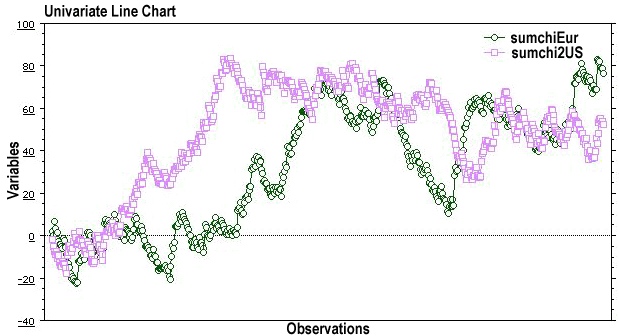| New Years 1999, Bierman report | ||||||||||||
| Dick Bierman made
precise predictions for the egg activity around the New Year transition, addressing
comparisons between eggs in Europe and the USA. His assessments also included examination of the intercorrelation of the individual data streams.Here are the very preliminary results of the analysis comparing US based RNGs (REGs) with European based RNGs around dec.31 23:00 UTC (midnight in Netherlands, Germany and Switzerland). The bad news: The predicted difference in variance during the first minute after midnight (with 1 sec time resolution) couldn't be confirmed (see graph below for the plot of cumulative chi2).  However: There appears to be a difference developing
during the last 5 minutes of the European year due to first an increase in variance in he
US-RNG's followed about 60 seconds later by an increase in variance in the Europeans.
Furthermore there is a sudden drop in variance of the European RNG's in the second minute
after midnight which is recovered in mins 3, 4 and 5. (see graph below which covers the 10
minutes around midnight) When comparing the compound behaviour of European vs US
(Eastern) RNG's at the eastern new year the global picture is similar to the one I have
sent for the same comparsion at the European new year. So this runs again against my hypothesis (i.e. there is no notable extra variance in the US - RNG's during the first minute of their new year). However during the 5 minutes preceding this moment the European RNG's are increasing strongly like the US RNG's were doing before europes new year. Then at midnight the cumulative chi-squares come together agian and stay close till minute +03:30 at which point the europeans take off again. I also looked at the correlation between the compound scores within each minute and found no systematic behaviour. Most correlations are negative and the over-all correlation (over 10 minutes) is -0.065 (p = 0.11 two-tailed). The good news: There appears to be some strange correlation
between the European as a whole and the US-RNG's as a whole. 5 and 4 minutes before
midnight the correlation is positive, dropping to nothing just before midnight, and
turning into negative after midnight with the following correlation coefficients: I did not download more data than this but it seems to me that this may be a promising avenue. (the 3 minutes after midnight as a whole are significant on itself). Lots' of work to do. Dick Correlations on New Year's dayFrom bierman@psy.uva.nl Sun Jan 3 01:03:01 1999 Happy new year to all, Stimulated by James' persistant request to look for correlations between RNG's behaviour I have analyzed the first 6 hours after the new year hit the eastcoast. I made a correlation matrix of the Z^2 per 15 minutes of 8 RNG's some of them in Europe some in the US. There are 28 R's in the matrix so one would expect 1 or 2 significant values just by chance. And of course I could have choosen all kinds of hours to analyze but these are not completely post hoc (I never did this particular type of analysis before) In the table below I give the significant pairs (N=24):
No significant negative correlations. DickEmail: rdnelson@princeton.edu |

